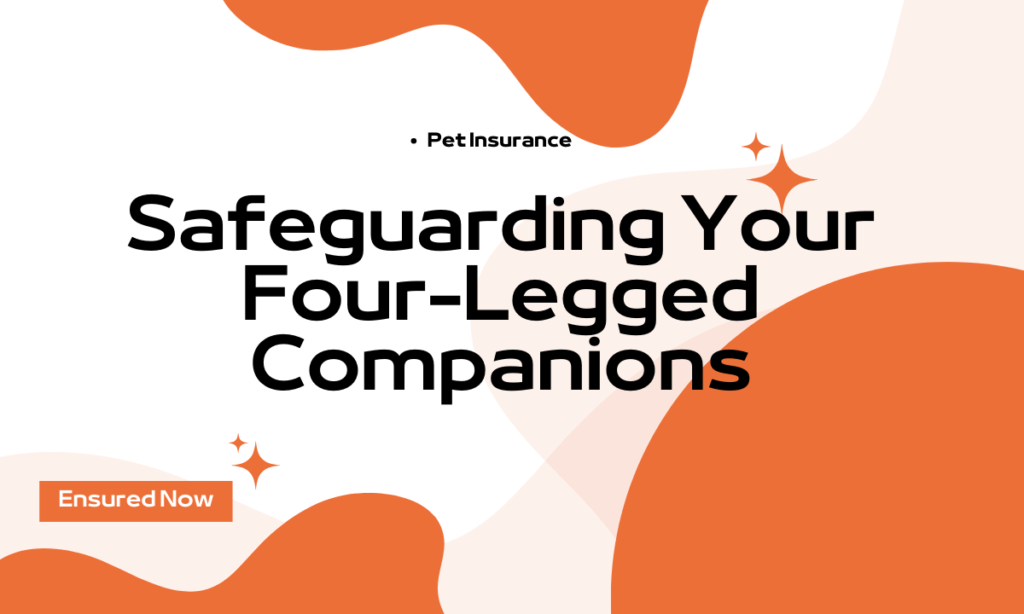The Ultimate Guide to Pet Insurance: Safeguarding Your Four-Legged Companions
Hey there, fellow pet parents! If you’ve landed on this page, it shows that you’re one of us – the type who considers their pet as part of the family and wants the very best for them. So let’s chat about pet insurance, shall we?
I. Introduction to Pet Insurance
An Overview: Defining Pet Insurance
Consider pet insurance as a safety net for your pet’s health. Just as humans have health insurance, pets have their own version to cover the hefty vet bills they can incur. It’s like your pet’s personal health bodyguard, ready to take down that unexpected illness or accident.
Brief History: Evolution of Pet Insurance
History time! The concept of pet insurance might seem modern, but it has its roots way back in 1890. Sweden was the trailblazer, with the first policy covering livestock. Fluffballs like dogs and cats had to wait until 1924 for their turn. In the U.S., pet insurance began its journey in the 1980s. Guess who was the first policyholder? It was Lassie, the beloved TV star dog!
Purpose & Benefits: Why Pet Insurance is Essential
Pet insurance boils down to peace of mind. It gives you a financial cushion when hard times hit your pet. The benefits of pet insurance can be a lifesaver, or in this case, a ‘petsaver’. It covers expensive veterinary costs from accidents to surgeries, certain illnesses and could even help with routine checkups!
II. The Nuts and Bolts of Pet Insurance
Understanding Policies: Deciphering Pet Insurance Coverage
Peeling back the layers of pet insurance can be a little like pawing through a dog’s chew toy graveyard – a bit messy. Some policies cover just accidents; others cover accidents and illnesses, and some even cover wellness visits. The deal is to find the one moment when your pet bounces off the walls after too many doggy treats.
Components of Pet Insurance: Premiums, Deductibles, and Payout Limits
Like a squirrel to a nut, let’s break this down. Premiums are your payment for the insurance policy. Deductibles are what you have to cough up before your insurer starts fitting the bill. Payout limits are the maximum dollar amount that an insurance company will reimburse. Together, these three churn the wheels of the insurance machinery.
Pet Insurance Exclusions: What’s Not Covered?
Now here’s the catnip. Some things, like pre-existing conditions, breeding costs, or certain hereditary conditions, aren’t typically covered. Look at it like this, if your Labrador loves to eat socks, his insurance might not cover the surgery to remove the latest chewed up ankle warmer
III. Pet Health & Insurance Needs
Role of Age and Breed in Insurance Needs
A Chihuahua’s pet insurance likely won’t look the same as a Saint Bernard’s policy. Breed, similar to one’s preference for bones versus balls, plays a role in insurance. Additionally, age also matters. The older the pet, the pricier the insurance, because let’s face it, growing old comes with some health glitches.
Pre-existing Conditions: Implications for Pet Insurance
If your pet has a pre-existing condition, it might be a steep hill to climb. Think of this as the pet insurance’s ‘Not-It’ tag. It means the condition was present before the policy coverage kicked in, so they might not cover the medical bills for that. On the bright side, not all pre-existing conditions are treated the same. So don’t lose hope!
Tailoring Insurance to Your Pet’s Specific Health Needs
When crafting a pet insurance policy, keep in mind your pet’s specific health needs. If Fido has a fondness for swallowing unusual objects or Fluffy suffers from a chronic condition, make sure your policy can cater to these needs. One size definitively doesn’t fit all in pet insurance.
IV. Exploring Different Pet Insurance Providers
What to Consider when Comparing Insurance Providers
When comparing pet insurance providers, think beyond the price tag. Consider factors like what’s actually covered, waiting periods, reimbursement percentages, and customer reviews. It’s like finding the perfect dog park – you need the right mix of space, location, and acceptable barking levels.
Breakdown of Popular Pet Insurance Providers
If pet insurance providers were a group of dogs, it’d be a diverse pack – Each unique, each offering something different. Some of the feisty dogs with praiseworthy offerings include Pets Best, Healthy Paws, and Embrace. But don’t take my word for it. Dive into their specifics, sniff out the details, and choose the one that best fits your pet’s needs.
Navigating Insurance Provider Reviews and Customer Experiences
Remember, every pet parent’s experience will vary. It’s essential to sift through the reviews and customer experiences with a critical eye. It’s a lot like scrolling through an online pet store; remember to read between the lines to understand the whole picture.
V. Filing a Claim: Pet Insurance in Action
The Claim Process: A Step-by-Step Guide
Filing a claim with pet insurance is like teaching your pet a new trick; it involves a few steps but is ultimately rewarding. You pay up front at the vet’s, submit a claim to your insurer, then wait for them to review the claim and get your reimbursement. Pretty straightforward, right?
Tips for a Successful Claim
A few treats could help to teach your pet to fetch, but when it comes to filing a claim, these tips might do the trick. Keep your pet’s medical records handy, follow the claim filing protocol to the tee, and don’t delay in filing your claims. Remember, patience is key, just like waiting for your dog to finally drop that ball.
Dealing with Disputes & Challenges in Claim Resolution
Disputes can ruffle your feathers, but knowing how to navigate them can smoothen out the convolutions. If you feel like your claim was unjustly denied, don’t hesitate to appeal the decision. Pet parents, stand your ground and seek clarifications for everything you do not understand. It’s a little like convincing your dog that the vet isn’t that scary — persistence is king.
VI. Making the Decision: Choosing the Right Pet Insurance
Prioritizing Your Pet’s Healthcare Needs
Choosing the right pet insurance means putting your pet’s health care needs right at the center of your decision. It’s akin to choosing between an organic pet meal and a quick fast-food pick-me-up; the better diet is always worth the hustle.
Estimating Costs and Evaluating Affordability
When evaluating pet insurance, keep an eye on your budget. Determine whether the cost of the premium fits your financial fabric without straining it. Pet insurance should provide financial comfort, not a squeeze.
The Long-Term Value of Pet Insurance
While pet insurance seems like an additional cost, it’s essential to appraise its value over the long run. Think of it like a choice between a flimsy dog toy and a slightly higher priced, durable one — the real value lies not on the upfront price tag, but the long term benefits.
VII. Conclusion
Recap: Insights on Pet Insurance
So, pet insurance may seem like a labyrinth, but with a little research, it doesn’t need to be more complicated than a game of fetch. The gains can be substantial: peace of mind, coverage for unexpected illnesses or accidents, and help with those vet bills that can add up quicker than your cat’s disdain for the dog.
Making an Informed Decision: Wrapping Up
Doing your research, understanding your pet’s needs, and fitting insurance into your budget can make this decision easier than coaxing a cat into a carrier.
Moving Forward: Next Steps for Pet Insurance Acquisition
Moving forward, consult with your vet, chat with your fellow pet parents, or simply ponder over it while you’re on a dog walk. Trust me, you will strike the balance between optimum coverage for your pet and affordability.

VIII. Frequently Asked Questions (FAQs)
FAQ 1: Is pet insurance really worth it?
- Absolutely! It acts like a small leak in the ship for all the unexpected medical emergencies that threaten to capsize your savings.
FAQ 2: Does pet insurance cover routine check-ups and vaccinations?
- Pet insurance plans vary. Some offer coverage for wellness visits and vaccinations. It’s like picking treats for your pet; some are just more stuffed with goodies than the others.
FAQ 3: What happens if my pet has a pre-existing condition?
- Most pet insurances are like that one friend who forgets about you when it gets tough – they don’t cover pre-existing conditions. But some can reconsider if your pet remains symptom-free for a while.
FAQ 4: Can I switch pet insurance providers down the line?
- Sure, you can. The process might seem as tricky as training your old dog with a new trick, but it’s doable. Just ensure you thoroughly understand the new policy before making the hop.
FAQ 5: What do I do if my insurance claim gets denied?
- If your claim is denied, contact your insurance provider for clarification. It is crucial to understand why it was denied and whether you can appeal the decision. Sometimes, it’s just a matter of presenting additional medical records or explaining the treatment better.
Alright folks, that’s all the wisdom I have to share today. Remember to go forth and choose wisely, because when it comes to our pets, they deserve the very best! For any health in visit this website MedihealthPedia
Keywords: c a r insurance, geico insurance, and car insurance, state farm insurance.
aaa pet insurance, admiral pet insurance, agria pet insurance, akc pet insurance, allstate pet insurance, animal friends pet insurance, argos pet insurance, asda pet insurance, aspca pet insurance, average cost of pet insurance




